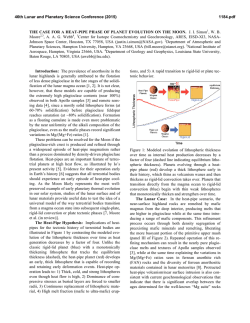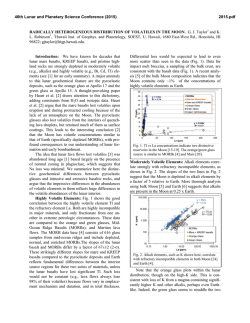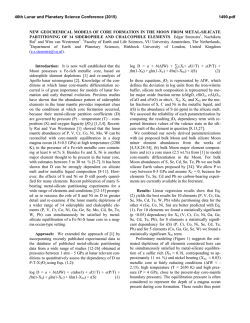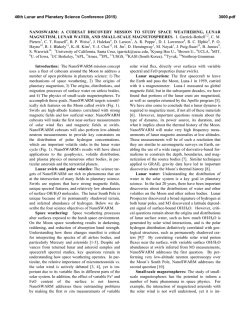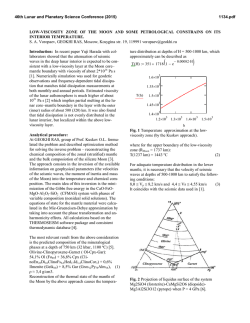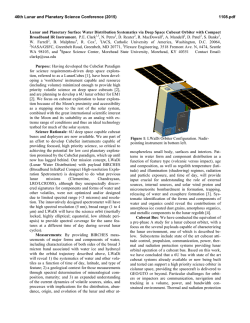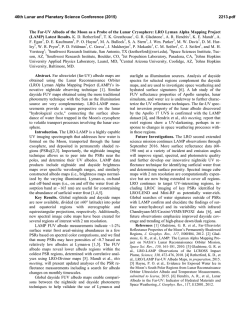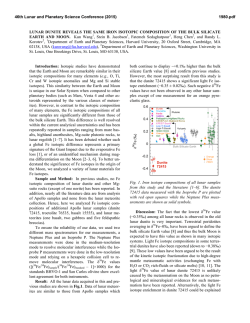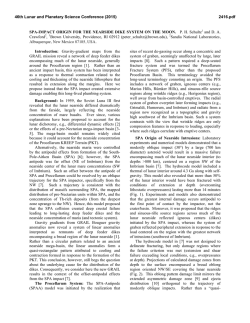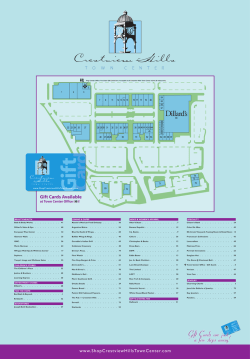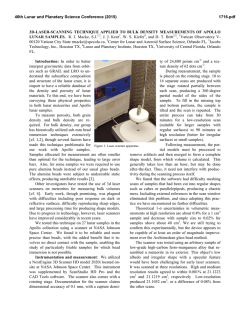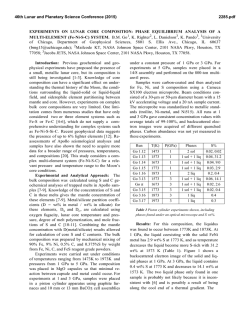
Science Priorities for Lunar Exploration Missions and Value of
46th Lunar and Planetary Science Conference (2015) 2616.pdf SCIENCE PRIORITIES FOR LUNAR EXPLORATION MISSIONS AND VALUE OF CONTINUED LRO OPERATIONS FOR FUTURE LUNAR GEOSCIENCE. Brad Jolliff1, Sam Lawrence2, Noah Petro3, Ryan Clegg1, Amanda Stadermann1, and Michael Zanetti1, 1Department of Earth and Planetary Sciences and the McDonnell Center for the Space Sciences, Washington University, One Brookings Dr., St. Louis, MO 63130; 2School of Earth and Space Exploration, Arizona State University, Tempe AZ; 3Goddard Space Flight Center, Greenbelt, MD ([email protected]) Introduction: As the Lunar Reconnaissance Orbiter (LRO) begins its second extended mission (ESM2) [1], the collection of data, especially targeted LROC NAC (Narrow Angle Camera) imaging, continues to provide information that will enable future lunar exploration missions. The Moon’s Poles have been identified as very high priority targets for the next stages of exploration that will follow successful LCROSS mission results [2]. In addition to the Poles, numerous targets of high science priority exist, and three are discussed here as examples of important classes of science awaiting future lunar exploration. Here we discuss (1) the South Pole-Aitken (SPA) Basin, which has been identified as a high priority for Solar System Science in two decadal surveys, most recently [3], (2) young volcanics on the Moon, such as the basalts south of Aristarchus Crater and Plateau [4,5], and (3) the Compton-Belkovich Volcanic Complex as an example of extreme magmatic differentiation on the Moon [6]. For all three of these exploration targets, determining the age and timing of events are key objectives. The SPA basin chronology offers insight into the timing and cause of late heavy bombardment and Solar System dynamics; the age of the youngest basalts offers insight into the cooling and interior magmatic evolution of the Moon as the small endmember of the differentiated terrestrial planets; and the age, composition, indigenous volatile content, and mineralogy of the Compton-Belkovich silicic volcanics offer insights into the origin of extreme magmatic differentiation on the Moon. Current science questions and potential mission approaches are discussed below. South Pole-Aitken (SPA) Basin: The issue that makes SPA sample return of interest as a NewFrontiers-class mission is to determine the age of the SPA impact and the chronology of large impacts within SPA [7] (Fig. 1). This mission requires collection and return of rock materials to Earth for high-precision chronologic studies to determine ages of impact-melted materials formed by the SPA impact event. Such investigations will also reveal rock types and mineralogy of SPA basin materials that can be used to (1) test the emerging paradigm of SPA “crust” as a thick, differentiated impact melt complex, e.g., [8,9], (2) better understand the giant impact-basin formation process on terrestrial planets, (3) measure the composition and ages of basalts to determine mantle composition and heterogeneity, and (4) test for the existence and possible het- erogeneity of KREEP components, with implications for thermal evolution of the Moon. Exploration objectives for the SPA basin can be achieved by robotic sample return [10] and by various schemes for astronaut-assisted or landed missions [11]. LRO coverage of SPA basin targets with NAC images continues to increase and images for geometric stereo have been obtained for >200 locations, including coverage of interior targets of SPA as well as Schrödinger basin, which is also an interesting exploration target in its own right [12]. NAC-derived digital terrain models will enable landing-site-safety assessments for robotic landings in numerous locations within SPA basin. Basalts South of Aristarchus: Basaltic plains in many locations on the Moon have been age-dated using crater size-frequency distributions (CSFD) [4,13]. These relatively flat and extensive volcanic surfaces are the ideal types of surfaces for this method, which, on the Moon, is grounded by knowledge of accurately determined ages of basaltic samples returned from Apollo and Luna missions. Hiesinger et al. [4] determined the age of a large volcanic unit directly south of the Aristarchus Plateau (Fig. 2), delineated using Clementine UV-VIS color data (P60) to be 1.2 Byr old (see also [13]). Although the CSFD measurements are compelling, nearly all areas of the Moon are riddled with secondary craters, not all of which are readily distinguished [14]. Thus, although relative ages are well determined, the question of accuracy and the actual age of the youngest mare basalt flows and other apparently young volcanic features [15,16] remains a key question [17]. Indeed, an entire session at this conference is devoted to the question of ‘how young is young’ for various lunar terrain features that can now be seen at half-meter per pixel resolution using NAC images. The basalt unit south of Aristarchus is of special interest owing to its proximity to Aristarchus crater, which is one of the youngest of the large Copernican craters [18,19] and the fact that the basalt unit P60 is peppered by ejecta from Aristarchus, making a sample of the regolith there ideal for a number of science objectives. Aristarchus Plateau and Crater are among the best covered features by LRO NAC imaging on the Moon, but the surrounding basalt units have received less attention. On-going targeting during ESM2 is aimed at improving coverage of the AristarchusHarbinger region. 46th Lunar and Planetary Science Conference (2015) Compton-Belkovich Volcanic Complex (CBVC): This enigmatic 25×35 km silicic volcanic complex (Fig. 3) represents a small group of petrologically and chemically evolved volcanic exposures on the Moon that are rich in silica as revealed by Diviner data [20] and incompatible elements, represented by Th determined from orbital gamma-ray spectroscopy [21]. Other prominent silicic volcanic sites are the Gruithuisen and Mairan Domes, Hansteen Alpha, and Lassell Massif. Compositions are critical to understand how these features formed, and although relative ages can be constrained, an absolute age for one of these features compared to spatially associated non-mare volcanics would also help us understand why they occur where they do. The CBVC occurs well beyond the main extent of the Procellarum KREEP Terrane and has several other features that argue for a high priority for future exploration. The CBVC features a variety of volcanic landforms in close proximity, including cones, domes, irregular collapse features interpreted to be calderas, high reflectance areas interpreted to be exposures of felsic volcanics [22], possibly high indigenous OH contents on the basis of Chandrayaan M3 data [23,24], and possible pyroclastic deposits [25,26]. The site is ideally suited for in-situ analysis by a rover equipped with chemical and mineralogical analyzers, including the capability (e.g., neutron spectroscopy) to sense H insitu to confirm the M3 interpretations, and Th, to confirm interpretations of the Lunar Prospector gamma-ray data [25]. Although the far-side location and high northern latitude complicate surface operations (communications require a relay Comsat), future plans for lunar exploration by other countries or international partnerships may open up this frontier and make landed exploration possible. LROC NAC imaging of the CBVC is complete, including digital topographic (DTM) coverage. Conclusions: Although only three science sites are highlighted here, many other sites of high science interest have been targeted for NAC imaging, such as the 50 Constellation sites. For these and other targets, NAC imaging, NAC geometric stereo imaging, and NAC photometric imaging for compositional studies, including Apollo and Luna landing sites for ground truth [e.g., 27] have been completed and are now being conducted for additional scientific targets. Owing to extended LRO mission operations, characterization of these sites is providing the data needed for landing and surface operations as well as scientific planning and geologic context, including global WAC color data [28] (Figs. 13) and Diviner thermal data [e.g., 29]. Acknowledgements: NASA and Community Support for the LRO Second Extended Mission. 2616.pdf Figure 1. Northern SPA region, LROC WAC color. Figure 2. Aristarchus & basalt unit P60, LROC WAC color. Figure 3. CBVC and surrounding region, LROC WAC color. References: [1] Keller J. et al. (2014) Lunar Planet. Sci. 45, #2294; [2] Colaprete A. et al. (2010) Science, 330(6003), 463-468; [3] NRC (2011) Vision and Voyages for Planetary Science in the Decade 2013-2022, Nat. Acad. Press, Washington, DC; [4] Hiesinger H. et al. (2003) J. Geophys. Res. 108, E7; [5] Lawrence S. et al. (2014) LEAG Ann. Meeting, #3062. [6] Jolliff B. et al. (2011) Nat. Geosci. 4, 566-571; [7] Jolliff B. and Petro N. (2014) Lunar Planet. Sci. 45, #2357; [8] Vaughan, W., and J. Head (2013) Planet. Space Sci. 91, 101106; [9] Hurwitz D. and Kring D. (2014) J. Geophys. Res. 119, 1110-1133; [10] Jolliff B. et al. (2014) Science & Challenges of Lunar Sample Return, ESTEC, Noordwijk, Netherlands Feb. 18-19; [11] Alkalai L. et al. (2013) LEAG #7034; [12] Kring D. and Durda D. (2012) LPI Contrib. No. 1694, 688p. [13] Hiesinger H. et al. (2000) J. Geophys. Res., 105, 29,239-229,275; [14] Stadermann A. et al. (2015) This Conf.; [15] Braden S. et al. (2014) Nat. Geosci. 7, 787–791; [16] Robinson M. et al. (2015) This Conf.; [17] Lawrence S. et al. (2011) LPI Contrib. 1611, 5047; [18] Koenig B. and Neukum G. (1976) Proc. Lunar Sci. Conf. 7, 2876-2881; [19] Zanetti M. et al. (2014) Lunar Planet. Sci. 45, #1528; [20] Glotch T. et al. (2010) Science 329, 1510-1513; [21] Lawrence D. J. et al. (1999), Geophys. Res. Lett. 26, 2681-2684; [22] Clegg R. et al. (2014) Lunar Planet. Sci. 45, #1256; [23] Petro N. et al. (2013) Lunar Planet. Sci. 44, #2688; [24] Battacharya S. et al. (2013) Current Sci. 105, 685-691; [25] Wilson J. et al. (2015) This Conf.; [26] Clegg R. et al. (2015) This Conf.; [27] Clegg R. et al. (2014) Icarus 227, 176-194; [28] Sato et al. (2014) J. Geophys. Res. 119, 1775–1805; [29] Greenhagen B. et al. (2014) Lunar Planet. Sci. 45, #2641.
© Copyright 2026
